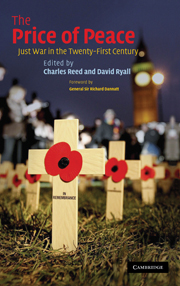Book contents
- Frontmatter
- Contents
- Notes on contributors
- Foreword by Richard Dannatt
- Acknowledgements
- 1 Introduction
- PART I A framework for ethical decision making: state and civil society-based approaches
- PART II Responding justly to new threats
- PART III Fighting wars justly
- PART IV Securing peace justly
- PART V Concluding reflections
- Bibliography
- Index
Foreword by Richard Dannatt
Published online by Cambridge University Press: 03 December 2009
- Frontmatter
- Contents
- Notes on contributors
- Foreword by Richard Dannatt
- Acknowledgements
- 1 Introduction
- PART I A framework for ethical decision making: state and civil society-based approaches
- PART II Responding justly to new threats
- PART III Fighting wars justly
- PART IV Securing peace justly
- PART V Concluding reflections
- Bibliography
- Index
Summary
Successive generations in the twentieth century confronted the prospect of war as an ugly but inevitable characteristic of their times. The tone was set by the Boer War, became harsher in the First World War, more universal in the Second World War and took on the potential for total destruction in the Cold War. But then, despite what many saw as the aberration of the first Gulf War in 1990–1, there appeared to be the prospect of an era when swords could indeed be beaten into ploughshares, peace dividends taken and a belief that the likelihood of war – hot or cold, declared or undeclared – had receded. However, 9/11 shattered the last vestiges of that dream. But on reflection, the audit trail to the contemporary security situation had already been marked out.
Although the collapse of the Berlin Wall was the headline event that signalled a switch from the classic focus on Defence to an increasing emphasis on Security, the use of force to achieve political ends did not cease but merely began to change. With certain exceptions in sub-Saharan Africa and in the Middle East, the prospect and incidence of inter-state war sharply declined, while wars amongst the people became a hallmark of the last decade of the twentieth century and on into the first decade of the twenty-first.
- Type
- Chapter
- Information
- The Price of PeaceJust War in the Twenty-First Century, pp. xi - xviPublisher: Cambridge University PressPrint publication year: 2007



